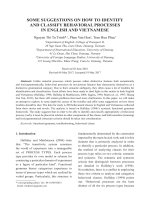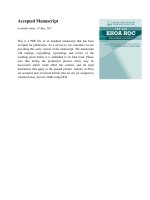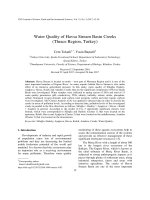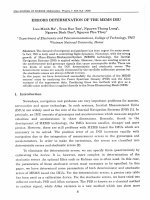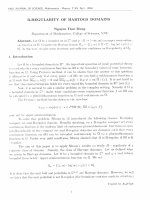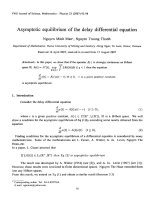DSpace at VNU: Fast Pyrolysis of Spent Coffee Waste and Oak Wood Chips in a Micro-tubular Reactor
Bạn đang xem bản rút gọn của tài liệu. Xem và tải ngay bản đầy đủ của tài liệu tại đây (217.58 KB, 11 trang )
This article was downloaded by: [New York University]
On: 02 June 2015, At: 16:51
Publisher: Taylor & Francis
Informa Ltd Registered in England and Wales Registered Number: 1072954 Registered
office: Mortimer House, 37-41 Mortimer Street, London W1T 3JH, UK
Energy Sources, Part A: Recovery,
Utilization, and Environmental Effects
Publication details, including instructions for authors and
subscription information:
/>
Fast Pyrolysis of Spent Coffee Waste
and Oak Wood Chips in a Micro-tubular
Reactor
a
b
c
T.-A. Ngo , J. Kim & S.-S. Kim
a
Department of Chemical Engineering, Ho Chi Minh City University
of Technology, Ho Chi Minh City, Vietnam
b
Department of Chemical Engineering, Kyung Hee University,
Yongin, Gyeonggi-do, Korea
c
Click for updates
Department of Chemical Engineering, Kangwon National University,
Samcheok, Gangwon-do, Korea
Published online: 28 Apr 2015.
To cite this article: T.-A. Ngo, J. Kim & S.-S. Kim (2015) Fast Pyrolysis of Spent Coffee Waste and
Oak Wood Chips in a Micro-tubular Reactor, Energy Sources, Part A: Recovery, Utilization, and
Environmental Effects, 37:11, 1186-1194, DOI: 10.1080/15567036.2011.608779
To link to this article: />
PLEASE SCROLL DOWN FOR ARTICLE
Taylor & Francis makes every effort to ensure the accuracy of all the information (the
“Content”) contained in the publications on our platform. However, Taylor & Francis,
our agents, and our licensors make no representations or warranties whatsoever as to
the accuracy, completeness, or suitability for any purpose of the Content. Any opinions
and views expressed in this publication are the opinions and views of the authors,
and are not the views of or endorsed by Taylor & Francis. The accuracy of the Content
should not be relied upon and should be independently verified with primary sources
of information. Taylor and Francis shall not be liable for any losses, actions, claims,
proceedings, demands, costs, expenses, damages, and other liabilities whatsoever or
howsoever caused arising directly or indirectly in connection with, in relation to or arising
out of the use of the Content.
This article may be used for research, teaching, and private study purposes. Any
substantial or systematic reproduction, redistribution, reselling, loan, sub-licensing,
systematic supply, or distribution in any form to anyone is expressly forbidden. Terms &
Downloaded by [New York University] at 16:51 02 June 2015
Conditions of access and use can be found at />
Energy Sources, Part A: Recovery, Utilization, and Environmental Effects, 37:1186–1194, 2015
Copyright © Taylor & Francis Group, LLC
ISSN: 1556-7036 print/1556-7230 online
DOI: 10.1080/15567036.2011.608779
Fast Pyrolysis of Spent Coffee Waste and Oak Wood Chips
in a Micro-tubular Reactor
T.-A. Ngo,1 J. Kim,2 and S.-S. Kim3
Downloaded by [New York University] at 16:51 02 June 2015
1
Department of Chemical Engineering, Ho Chi Minh City University of Technology, Ho Chi Minh
City, Vietnam
2
Department of Chemical Engineering, Kyung Hee University, Yongin, Gyeonggi-do, Korea
3
Department of Chemical Engineering, Kangwon National University, Samcheok,
Gangwon-do, Korea
Fast pyrolysis of spent coffee waste, a major non-cellulosic material, and oak wood chips, a cellulosic
material, was carried out in a micro tubular reactor over a temperature range of 550 to 750°C with
sweep gas flow rates of 20 and 500 mL/min. When the temperature was raised from 550 to 750°C, the
gas yields were significantly enhanced, but the liquid yields were reduced. The highest liquid yield,
63.4 wt%, was obtained after pyrolysis of spent coffee waste at 550°C at a sweep gas rate of 500 mL/
min. The highest gas yield, 65.74 wt%, was obtained after pyrolysis of the oak wood chips at 750°C at
a sweep gas flow rate of 20 mL/min. The gas products primarily included considerable amounts of CO,
CO2, and hydrocarbon-rich gases but no hydrogen. Furthermore, regardless of the biomass source, the
hydrocarbon-rich gases were qualitatively similar and largely consisted of methane, ethane, ethylene,
propane, and propylene. The gas chromatography-mass spectrometry analysis of the pyrolyzed bio-oils
demonstrated that the major compounds were phenol derivatives, aldehydes, ketones, acids, and
alcohols.
Keywords: biomass, cellulosic biomass, fast pyrolysis, non-cellulosic biomass, tubular reactor
INTRODUCTION
Recently, there has been an increased interest in studies on biomass conversion into fuel. Various
methods have been, such as fermentation (Lin and Tanaka, 2006), hydrolysis (Sun and Cheng,
2002), and pyrolysis (Raveendran et al., 1996; Kim et al., 2009; Kaushal and Abedi, 2010, Yu
et al., 2011; Yaman, 2004). Pyrolysis is a promising method due to its reasonable cost and simple
operation and can be classified into two approaches based on the heating rate and gas retention
time (Bridgwater, 2003). Conventional pyrolysis involves decomposition at a low heating rate and
long retention time to produce charcoal. Fast pyrolysis occurs with a very high heating rate over a
short retention time, largely for achieving a high yield of biological oils, known as bio-oil. Since
Address correspondence to S.-S. Kim, Department of Chemical Engineering, Kangwon National University, Samcheok,
Gangwon-do 363-883, Korea. E-mail:
Color versions of one or more of the figures in the article can be found online at www.tandfonline.com/ueso.
1186
Downloaded by [New York University] at 16:51 02 June 2015
FAST PYROLYSIS OF COFFEE WASTE AND OAK WOOD CHIPS
1187
bio-oil is appealing as an alternative for depleted fossil-based fuels, fast pyrolysis is receiving
increasing attention.
Many types of reactors coupled with various biomass sources have been employed by researchers for the fast pyrolysis of biomass. For instance, Lappas et al. (2002) investigated the fast
pyrolysis of biomass (Lignocell HBS 150–500) in a fluidized bed reactor. Li et al. (2004)
developed a free fall reactor (a type of reactor used for fast pyrolysis) to conduct an experiment
using legume straw and apricot stone to obtain a hydrogen-rich gas fraction. Only a few studies,
however, have been reported on fast pyrolysis in a small reactor for lab-scale applications.
Therefore, a micro-tubular reactor, a small apparatus with a length of 50 cm, 75% shorter than
that of the free fall reactor reported in Li et al. (2004), was designed and applied for fast pyrolysis
in this study.
It should be noted that, while the major cellulosic material is the primary focus of most
studies, there have been very few reports referring to the major non-cellulosic material. With a
diversity of starting structures, the yields as well as the product properties are expected to
completely change when a particular biomass is used in fast pyrolysis. Spent coffee waste is
an abundant leftover non-cellulosic biomass collected from the production of the beverage, with
the major carbohydrate consisting of considerable amounts of arabinogalactan and galactomannans (Fischer et al., 2001; Oosterveld et al., 2003), and was chosen for this research.
Furthermore, oak wood chips, typically a major cellulosic biomass material, were also pyrolyzed
under the same conditions to serve as a reference of comparison. Using these two biomass
feedstocks, all experiments were performed at the temperature of 550–750°C in two different
sweep gas flow rates of 20 and 500 mL/min to compare the gas, liquid, and char yields after
pyrolysis. Subsequently, the gas and liquid product properties at selected conditions were studied.
From these results, the role of biomass composition and the effect of pyrolysis conditions were
clarified.
EXPERIMENTAL
The spent coffee waste and oak wood chips were ground with a knife mill to ca. 500 μm and then
exposed to air for 24 h. The samples were fast pyrolyzed in a vertical tubular reactor (ϕ2.54 cm ×
50 cm), which was designed 75% shorter than the free fall reactor by Li et al. (2004). For each run,
a 1.5-g sample was pre-placed in the feed hopper. When the set value of furnace temperature (550,
600, 650, 700, or 750°C) was reached, the on/off valve was subsequently switched on to allow
both the biomass sample and sweep gas (at a flow rate of 20 or 500 mL/min) to enter the reactor.
The liquid product was condensed and separated from the aerosol at the bottom of the condenser
(cooled with a eutectic mixture of 76.4 wt% sodium chloride and 23.6 wt% ice water at a
temperature of -21.8°C), while the gas product was emitted to and trapped in the water column.
After being held constant for 10 min, the flow of N2 was deactivated, the oven was turned off, and
the pyrolysis was completed.
In order to compare the characteristic of fast pyrolysis for each type of biomass, the yields of
product were calculated as follows:
Liquid yield ðwt%Þ ¼
Solid yield ðwt%Þ ¼
weight of liquid
 100%;
weight of biomas
weight of solid
 100%;
weight of biomas
Gas yield ðwt%Þ ¼ 100% À Liquid yield À Solid yield;
Downloaded by [New York University] at 16:51 02 June 2015
1188
T.-A. NGO ET AL.
where the weight of liquid product was determined as the difference in the weight of the condenser
before and after pyrolysis, and the weight of solid was obtained from weighted residue after
pyrolysis.
The gaseous product of biomass pyrolysis was quantitatively characterized using gas chromatography (GC) with a flame ionization detector (FID) and thermal conduction detector (TCD).
The GC-FID (M600D–Younglin) with an HP-Plot/Al2O3 column (50 m × 0.53 mm × 15 μm) was
used to analyze hydrocarbons, while a GC-TCD (ACME 6000GC–Younglin) with a molecular
sieve of 5A and a Porapak N column (80/100, 6 ft × 1/8 in., HP) were used to detect CO, H2, and
CO2. The liquid product was analyzed using gas chromatography-mass spectrometry (GC-MS)
with an HP-1 column (50 m × 0.32 mm × 0.52 µm) to identify the composition (Lappas et al.,
2002). The oven temperature was programmed to increase from 50 to 300°C at a heating rate of
10°C/min while the injector was maintained at 300°C. The water content was analyzed using a
method reported in the literature (Orzherovskii, 1969).
RESULTS AND DISCUSSION
Effect of Pyrolysis Conditions on Product Distribution
Figure 1 shows the product yields of fast pyrolysis for the two types of biomass. Spent coffee waste
was pyrolyzed for the highest liquid yield of 58.50 wt% at 550°C, compared to that of oak wood
chips with a liquid yield of 52.47 wt%. The gas yields from both biomasses were varied in the
range of 19.20–24.86 wt%, while the char yields were not very different in this temperature range,
changing from 22.30 and 24.86 wt%. By increasing the pyrolysis temperature from 550 to 750°C,
the major product changed from liquid to gas. At 750°C, the highest yield of a gaseous product
(65.74 wt%) was obtained with the pyrolysis of oak wood chips. In contrast, the liquid yields were
considerably decreased at this condition. Generally, it can be found that the gas yields increased
with increasing temperature, whereas the liquid and char yields decreased. As is commonly known,
cracking is an endothermic reaction; therefore, the increase in temperature could facilitate the
cracking of heavy molecules to produce smaller ones. As a result, the gas yield was enhanced
significantly, while both liquid and char yields decreased.
The liquid yield of the pyrolysis of spent coffee waste only slightly decreased with an increase
in temperature, whereas the liquid yield from oak wood chips was more noticeably reduced. This
indicated that the production of bio-oil from the pyrolysis of spent coffee waste was more
thermally stable than was that from pyrolysis of oak wood chips.
The effect of sweep gas flow rate was investigated based on a comparison of the product yields
obtained at the slow (20 mL/min) and fast flow rates (500 mL/min) at various pyrolysis temperatures, which ranged from 550 to 750°C. The product yield of fast pyrolysis at these conditions is
shown in Figure 2.
From Figures 1 and 2, it can be realized that the liquid yield at a fast N2 flow rate (500 mL/min)
increased in comparison with that at a N2 slow flow rate (20 mL/min). This might be because all
secondary cracking reactions in the pyrolysis process were significantly decreased when the
retention of vapor was reduced, thus resulting in an improved bio-oil yield and simultaneous
restriction of the gas yield.
Unexpectedly, all char yields from the pyrolysis of the two types of biomass at a fast flow rate
of N2 were also higher than those at the slower N2 flow rate. This increase might be explained
based on the changes in both the heat transfer and reaction pathway taking place in the pyrolysis
process. From the perspective of heat transfer, a higher sweep gas flow rate would facilitate greater
heat transfer rates from the surface of the biomass particle to the wall of the reactor. This could
result in insufficient energy at the core of the biomass particle, which could hinder complete
FAST PYROLYSIS OF COFFEE WASTE AND OAK WOOD CHIPS
1189
80
char
liquid
gas
Yield, wt%
60
40
0
550
600
650
700
750
700
750
Temperature, ºC
80
char
liq
gas
60
Yield, wt%
Downloaded by [New York University] at 16:51 02 June 2015
20
40
20
0
550
600
650
Temperature, ºC
FIGURE 1 Product yields of fast pyrolysis of biomass at 20 ml/min of N2 from 550–750°C: (a) spent coffee waste
and (b) oak wood chips.
decomposition; therefore, a small fraction of feedstock might remain after pyrolysis. As a result,
the solid yield in pyrolysis with a fast flow rate of sweep gas was always higher than that of the
slow sweep gas flow rate.
Due to the effect of reaction pathway, as reported by Liden et al. (1988), biomass was pyrolyzed
in two ways: one forming the mixture of tar and gas products, and another forming char. Based on
this reaction mechanism, when the flow rate of sweep gas is increased, the pyrolysis reaction might
be altered, preferably toward the formation of char.
Pyrolysis Product Properties
In order to investigate the effect of pyrolysis temperature, sweep gas flow rate, and biomass source
on product properties, the gases obtained were analyzed using GC-FID and GC-TCD to determine
the hydrocarbons and the abundances of CO, CO2, and H2, respectively. The analysis results of the
gas products at various conditions are presented in Figure 3.
1190
T.-A. NGO ET AL.
80
(a)
char
liquid
gas
Yield, wt%
60
40
0
550
600
650
700
750
Temperature, ºC
80
(b)
char
liq
gas
60
Yield, wt%
Downloaded by [New York University] at 16:51 02 June 2015
20
40
20
0
550
600
650
700
750
Temperature, ºC
FIGURE 2 Product yields of fast pyrolysis of biomass at 500 ml/min of N2 from 550–750°C: (a) spent coffee waste
and (b) oak wood chips.
As shown, when the temperature increased to 750°C, the yields of hydrocarbons and the
mixture of CO, CO2 from both biomass types were considerably enhanced, almost two- or threefold higher than those at 550°C. Specifically, for spent coffee waste at pyrolysis conditions of 550°
C and 20 mL/min, the contents of hydrocarbons and the mixture of CO, CO2 were 8.45 and 10.75
wt%, respectively, while those of pyrolysis at 750°C were 26.67 and 20.44 wt%. The GC-TCD
analysis revealed that there was no hydrogen in the gaseous products of the pyrolysis experiments
under the selected conditions. As reported by Rand and Dell (2008), hydrogen-forming reactions
commonly occur at elevated temperature, high pressure, and almost always with the use of
catalysts. In comparison with these conditions, it is obvious that the pyrolysis temperatures used
in this research were not sufficient to facilitate the reactions that produce hydrogen.
The effect of sweep gas flow rate on fast pyrolysis is demonstrated through the reduction of gas
yield, as well as the decrease in the yields of both hydrocarbon-rich gas and the mixture of CO,
CO2 when the flow rate was increased. Although the gas yield only slightly decreased with an
increase in the sweep gas flow rate between 5 and 15 wt% for both biomass at all temperatures, the
FAST PYROLYSIS OF COFFEE WASTE AND OAK WOOD CHIPS
70
60
1191
3
Hydrocarbon gas
CO + CO2
4
Yield, wt%
50
4
40
30
1
20
Downloaded by [New York University] at 16:51 02 June 2015
3
1
2
2
10
0
Spent coffee waste
Oak wood chip
FIGURE 3 The yields of hydrocarbon and the mixture of CO and CO2 in gaseous products of fast pyrolysis of spent
coffee waste and oak wood chips at different conditions: (1) 550°C, 20 mL/min; (2) 550°C, 500 mL/min; (3) 750°C,
20 mL/min; (4) 750°C, 500 mL/min.
secondary cracking reaction mentioned above was clearly retarded at the faster sweep gas flow
rates, thus leading to a lower gas yield but an improved bio-oil yield.
Finally, the effect of biomass source can be seen in Figure 3, where the gas yields from oak
wood chips as well as the yields of hydrocarbons and mixture of CO and CO2 were almost always
higher than those from the spent coffee waste at all conditions investigated. Additionally, regardless of the dissimilarity in structure of the major non-cellulosic and cellulosic biomasses, the
hydrocarbon compositions of both gaseous products obtained from pyrolysis of spent coffee waste
and oak wood chips were similar.
It was observed that the liquid yield, including both water and bio-oil yield, was directly
proportional to the sweep gas flow rate, which was explained in the previous section. After fast
pyrolysis at 550°C, the water contents in the liquid products were ca. 28 wt% from spent coffee
waste and ca. 36 wt% from oak wood chips, respectively. Czernik and Bridgwater (2004) reported
that the water in the liquid product was produced by the dehydration reaction, which occurred
during pyrolysis. The water content of oak wood chips was higher than that from spent coffee
waste, although the experiments were carried out at the same conditions. This difference could be
attributed to the usage of a different biomass source for pyrolysis. In fact, the oxygen contents of
spent coffee waste and oak wood chips were 34.5 and 38.55%, respectively. During pyrolysis,
these oxygen atoms were eliminated from the biomass to form water. Therefore, a higher oxygen
content in the biomass resulted in a higher water content in the liquid product.
In contrast with the water content, the bio-oil content from oak wood chips was lower than that
from spent coffee waste. It was difficult to explain this difference in bio-oil content due to the fact
that there were few factors that affect the formation of bio-oil, such as the molecular structure or
relative content of each compound in the biomass (cellulose, cellulose-like, and lignin).
Specifically, if these compounds contained a long chain hydrocarbon, a large amount of high
molecular weight bio-oil would result. In addition, lignin is known as a thermally stable compound
and can be decomposed to produce phenol derivatives, a common compound of bio-oil (Wei et al.,
2006). Hence, if this compound existed in abundance, it would lead to the creation of more
1192
T.-A. NGO ET AL.
TABLE 1
Major Bio-oil Products of the Fast Pyrolysis of Spent Coffee and Oak Wood
Downloaded by [New York University] at 16:51 02 June 2015
Spent Coffee Waste
1
2
3
4
5
6
7
8
9
10
11
12
13
14
15
16
17
18
19
20
Oak Wood Chips
Compound
Area, %
Compound
Area,%
Acetic acid
2-Propanone, 1-hydroxy1,3-Cyclopentanedione
2-Furanmethanol
3,4-Dihydropyran
2-Cyclopenten-1-one, 3-methylPhenol
2-Cyclopenten-1-one, 2-hydroxy-3-methyl
Phenol, 4-methylPhenol, 2,5-dimethyl1,2-Benzenediol
4-Vinylphenol
1,4-Benzenediol
Indolizine
2-Methoxy-4-vinylphenol
1,3-Benzenediol, 4-ethylPentadecane
Dodecanoic acid
Hexadecanoic acid
9,12-Octadecadienoic acid (Z,Z)-
5.1
2.9
5.0
4.3
2.0
1.8
3.9
2.9
3.9
1.6
6.9
1.4
2.0
3.2
2.0
1.9
1.2
3.4
10.9
7.9
Acetic acid
2-Furancarboxaldehyde
2-Furanmethanol
1,2-Cyclopentanedione
2-Furancarboxaldehyde, 5-methylPhenol
2-Cyclopenten-1-one, 2-hydroxy-3-methyl
Phenol, 2-methylPhenol, 4-methylPhenol, 2-methoxy1,2-Benzenediol
1,2-Benzenediol, 3-methoxy1,2-Benzenediol, 3-methylPhenol, 4-ethyl-2-methoxy1,2-Benzenediol, 4-methyl2-Methoxy-4-vinylphenol
Phenol, 2,6-dimethoxyPhenol, 3,4-dimethoxyPhenol, 2-methoxy-4-(1-propenyl)2,6-Dimethyl-3-(methoxymethyl)-p-benzoquinone
20.7
3.3
2.2
2.1
2.1
2.9
2.5
2.1
3.1
2.7
3.4
2.4
2.4
3.0
3.4
3.2
4.0
2.3
4.2
2.0
phenolic derivatives (bio-oil). Accordingly, additional measurements are needed to confirm the
important factors in the bio-oil yields of these two biomass sources.
Table 1 shows the major products obtained from the pyrolysis of spent coffee waste and oak
wood chips. As can be seen in the case of the oak wood chip sample, the bio-oil included mainly
phenol derivatives. As reported by Wei et al. (2006), these compounds were assumed to be
produced from the decomposition of lignin in the biomass. As for the spent coffee waste, these
phenol derivatives also existed in the liquid product but in a much smaller amount. Additionally,
considerable amounts of fatty acids and alkanes were detected. There is no research showing that
these compounds result from the pyrolysis of ligno-cellulosic biomass. Such compounds must be
derived from the decomposition of vegetable oil remaining in the biomass. This conclusion is
consistent with the mechanism for the formation of free fatty acid via pyrolysis of vegetable oil
(Jayadas and Prabhakaran, 2007; Schwab et al., 1988).
Furthermore, it is commonly known that hydrocarbon compounds with a higher molecular
weight have a higher decomposition temperature. This means that a high molecular-weight
compound would be more thermally stable than a low molecular-weight compound. As can be
seen in the composition of bio-oil resulting from the pyrolysis of spent coffee waste, fatty acids
of high molecular weight, such as dodecanoic or hexadecanoic acid (mainly including C12–C16
hydrocarbons), comprised a considerable fraction of the bio-oil. These fatty acids are more
thermally stable, and hence, they might remain after pyrolysis. As a result, the yield of bio-oil
produced from spent coffee waste was always higher than that of oak wood chips at all
investigated conditions.
Noticeably, almost all products were oxygenated compounds. The presence of these oxygen
atoms in the compounds resulted in a reduced bio-oil quality. An upgrading process was therefore
recommended for these bio-oils before they can be used as fuel.
FAST PYROLYSIS OF COFFEE WASTE AND OAK WOOD CHIPS
1193
CONCLUSIONS
Spent coffee waste, a major non-cellulosic biomass, and oak wood chips, a major cellulosic
biomass, were employed for fast pyrolysis in a micro tubular reactor at various conditions. The
effects of biomass source, temperature and sweep gas flow rate on the characteristics of fast
pyrolysis can be summarized as follows:
●
Downloaded by [New York University] at 16:51 02 June 2015
●
●
Fast pyrolysis was preferable for the production of a liquid product at 550°C, whereas a gas
product was preferable at 750°C. The highest yield of bio-oil from the spent coffee waste was
58.5 wt% when the pyrolysis temperature was 550°C at 20 mL/min. In contrast, at this
condition, pyrolyzed oak wood chips produced the highest gas yield at 65.74 wt%. Also, the
char yields varied in the range of 13.73–22.67 wt%.
When the sweep gas flow rate was increased, the liquid yields increased, the gas yields
decreased and the char yield unexpectedly increased compared to those at a slow flow rate.
The highest gas and liquid yields were 63.4 and 40.7 wt%, corresponding to the pyrolysis of
spent coffee waste and oak wood chips, respectively.
Regardless of biomass composition, the gases produced were qualitatively similar, largely
including carbon monoxide, carbon dioxide, methane, ethane, ethylene, propane, and
propylene. The major compounds of pyrolyzed bio-oils consisted of phenol derivatives,
aldehydes, ketones, acids and alcohols. Notably, there was a considerable amount of fatty
acids in the bio-oil obtained from spent coffee waste, thus imparting greater thermal
stability in this bio-oil.
FUNDING
This research was supported by Basic Science Research Program through the National Research
Foundation of Korea (NRF) funded by the Ministry of Education, Science and Technology (NRF2014R1A1A4A01008538).
REFERENCES
Bridgwater, A. V. 2003. Renewable fuels and chemicals by thermal processing of biomass. Chem. Eng. J. 91:87–102.
Czernik, S., and Bridgwater, A. V. 2004. Overview of applications of biomass fast pyrolysis oil. Energy Fuels 18:590–598.
Fischer, M., Reimann, S., Trovato, V., and Redgwell, R. J. 2001. Polysaccharides of green arabica and robusta coffee beans.
Carbohydr. Res. 330:93–101.
Jayadas, N. H., and Prabhakaran, N. K. 2007. Elucidation of the corrosion mechanism of vegetable-oil-based lubricants.
J. Tribol. 129:419–423.
Kaushal, P., and Abedi, J. 2010. A simplified model for biomass pyrolysis in a fludized bed reactor. J. Ind. Eng. Chem.
16:748–755.
Kim, S.-S., Agblevor, F. A., and Lim, J. 2009. Fast pyrolysis of chicken litter and turkey litter in a fluidized bed
reactor. J. Ind. Eng. Chem. 15:247–252.
Lappas, A. A., Samolada, M. C., Iatridis, D. K., Voutetakis, S. S., and Vasalos, I. A. 2002. Biomass pyrolysis in a circulating
fluid bed reactor for the production of fuels and chemicals. Fuel 81:2087–2095.
Li, S., Xu, S., Liu, S., Yang, C., and Lu, Q. 2004. Fast pyrolysis of biomass in free-fall reactor for hydrogen-rich gas. Fuel
Process. Technol. 85:1201–1211.
Liden, A. G., Berruti, F., and Scott, D. S. 1988. A kinetic model for the production of liquids from the flash pyrolysis of
biomass. Chem. Eng. Commun. 65:207–221.
Lin, Y., and Tanaka, S. 2006. Ethanol fermentation from biomass resources: Current state and prospects. Appl. Microbiol.
Biotechnol. 69:627–642.
Oosterveld, A., Harmsen, J. S., Voragen, A. G. J., and Schols, H. A. 2003. Extraction and characterization of polysaccharides from and roasted coffee arabica beans. Carbohydr. Polym. 52:285–296.
Downloaded by [New York University] at 16:51 02 June 2015
1194
T.-A. NGO ET AL.
Orzherovskii, M. A. 1969. Rapid thermochemical method of determining the water content of petroleum products. Chem.
Technol. Fuel Oils 5:61–63.
Rand, D. A. J., and Dell, R. M. 2008. Hydrogen Energy: Challenges and Prospects. Great Britain: The Royal Society of
Chemistry.
Raveendran, K., Ganesh, A., and Khilar, K. C. 1996. Pyrolysis characteristics of biomass and biomass components. Fuel
75:987–998.
Schwab, A. W., Dykstra, G. J., Selke, E., Sorenson, S. C., and Pryde, E. H. 1988. Diesel fuel from thermal-decomposition of
soybean oil. J. Am. Oil Chem. Soc. 65:1781–1786.
Sun, Y., and Cheng, J. 2002. Hydrolysis of lignocellulosic materials for ethanol production: A review. Bioresour. Technol.
83:1–11.
Wei, L., Xu, S., Zhang, L., Zhang, H., Liu, C., Zhu, H., and Liu, S. 2006. Characteristics of fast pyrolysis of biomass in a
free fall reactor. Fuel Process. Technol. 87:863–871.
Yaman, S. 2004. Pyrolysis of biomass to produce fuels and chemical feedstocks. Energy Convers. Manage. 45:651–671.
Yu, J., Yao, C., Zeng, X., Geng, S., Dong, L., Wang, Y., Gao, S., and Xu, G. 2011. Biomass pyrolysis in a micro-fluidized
bed reactor: Characterization and kinetics. Chem. Eng. J. 168:839–847.


